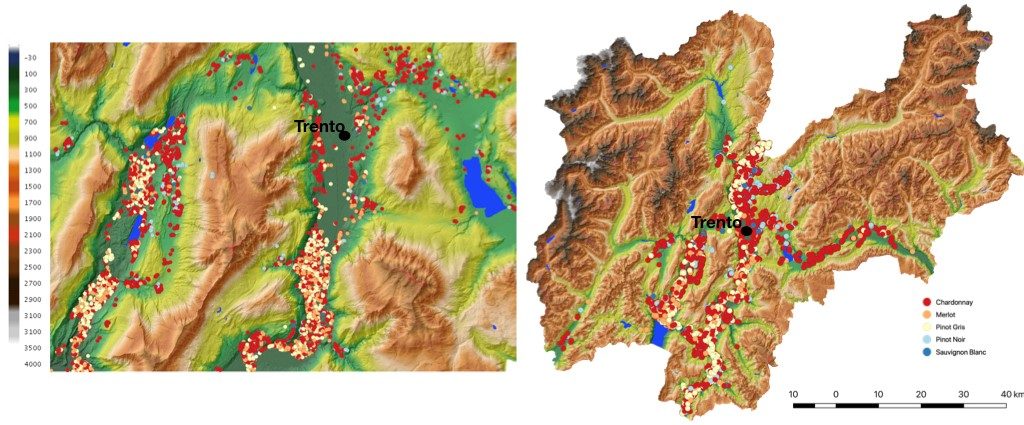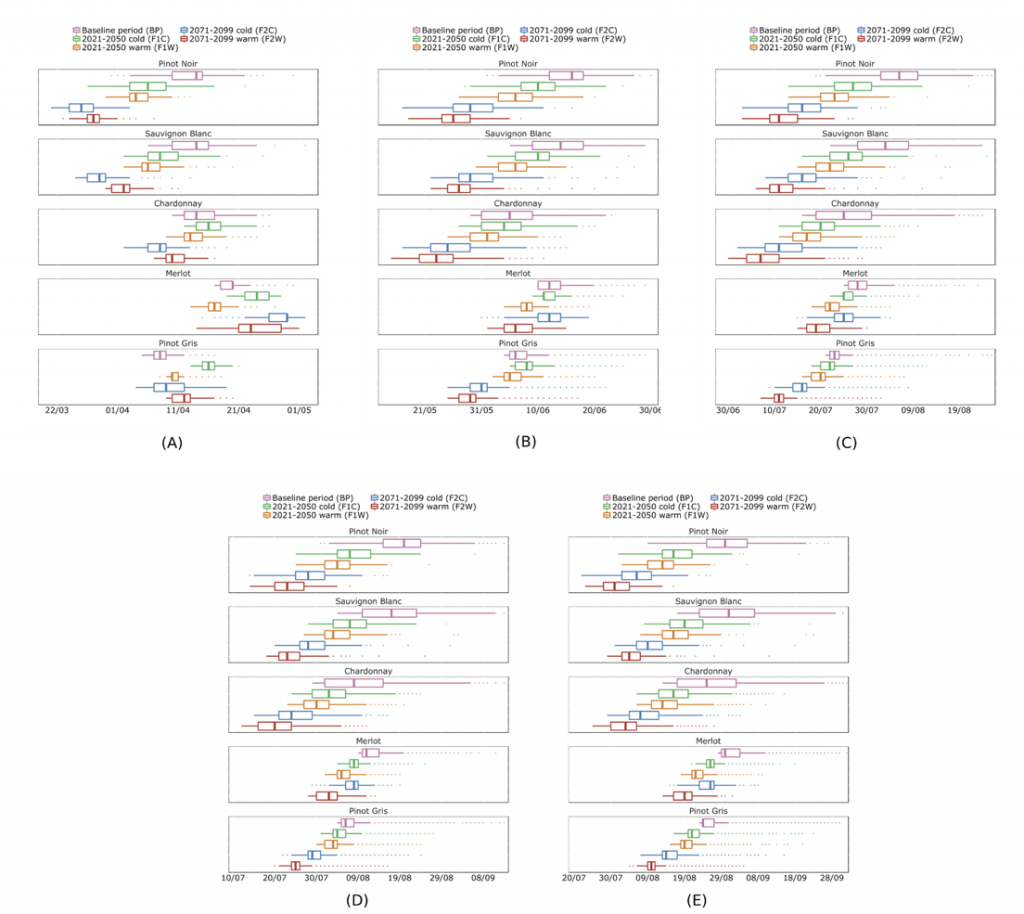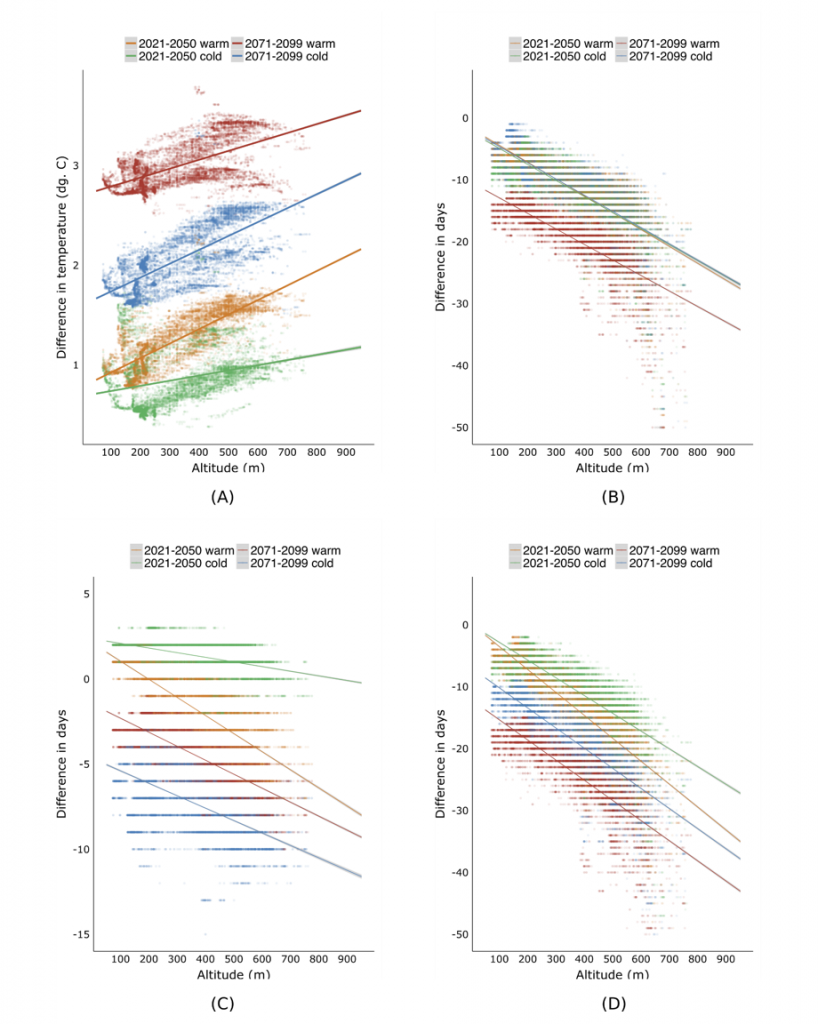By Azra Alikadić
In the near future, climate change is expected to significantly influence grape and wine quality (Jones et al., 2005). In fact, temperature is the main driver of grapevine phenology (Gladstones, 2011; Bock et al., 2011). In terms of climate change, the Mediterranean region is a climate “hot spot”, where temperature is expected to increase even more than in other world regions (Jones, 2007; Moriondo et al., 2013), leading to too warm conditions for the production of specific wine types (Jones et al., 2005). Simulations of the effect of climate change on the phenology of grapevines indicate shorter growing seasons, earlier occurrences of phases and shorter phase duration in the future.
In Alikadic et al., 2019 we took into consideration a geographically complex region, with a long history of wine production, the province of Trento in the Italian Alps. Wine industry is highly specialized in the region and several grapevine varieties are traditionally grown, both in the valley bottom and in several mountainous areas. Our aim was to assess the influence of climate change on grapevine phenology, considering the different features of five varieties (Chardonnay, Pinot Noir, Sauvignon Blanc, Merlot, Pinot Gris) and five phenological phases (Bud burst, Flowering, Fruit set, Veraison, Harvest) at different altitudes (from 67 m to 950 m a.s.l.), carried out in two future periods of time 2021-2050 and 2071-2099 (Figure 1).

The difference between the baseline period (the mean of 2002-2014) and the predicted scenarios increases significantly after budburst (Figure 2), following the trend of increased temperatures in the different scenarios and determining a progressive advancement of the phases as they approach harvest. Budburst shows a diverse correlation with temperature scenarios due to chilling requirements. In fact, higher temperatures can lead to a delayed attainment of this phase.
The following three grapevine phenophases (flowering, fruit set, and veraison) show the same trend in response to temperature increase. The difference between the baseline period and the predicted scenarios increases for each following phase, hence the difference is smallest for flowering and highest for veraison. All varieties have an earlier harvest date. The two varieties grown at the lowest elevations, Pinot Gris and Merlot, have the smallest difference between baseline period and F1, from five to ten days. The highest differences are for the varieties Pinot Noir, Chardonnay and Sauvignon Blanc and range from 10 up to 18 days. In the second time period, harvest is also advanced, reaching 30 days in the warm scenario (Pinot Noir).

The temperature is projected to increase more at higher altitudes, thus decreasing altitudinal gradient. As a consequence, the time span between different phenological phases at different altitudes is expected to shorten. In practice, a comparatively shorter “technical growing season” (TGS: budburst to harvest) is predicted for vineyards located at higher altitudes. The harvest time is significantly more influenced by altitude than the earliest phenological phase (budburst). It is observed that in the period 2021-2099 harvest timing is expected to decrease by approximately 3 days (100 m)-1, leading to a more concentrated harvest window for growers and especially for wineries, which are supposed to separately deal with each variety.

The expected effects of climate change are not homogeneous in a mountainous province like Trentino. In this region, a significant higher change in grapevine phenology is expected, following the higher increase in phenological forcing temperature at higher altitudes, where base values are lower. Harvest time advance will likely bring a shortening of the harvest time gap between mountain and valley-bottom sites, due to the faster phenological development at higher elevations. Hence, this change will require management adjustments in work scheduling for both grapevine growers and wine producers.
A proactive approach of grapevine growers to find new suitable areas for traditional varieties would bring benefits to quality maintenance of some wines and, at the same time, the introduction of new varieties could open a new market. In such case, a further assessment of the effects of the local environmental conditions on wine quality as well as a market assessment for new grape varieties is recommended. As a future perspective, we recommend development of a methodology for high-resolution crop suitability analysis that takes into consideration historical and predicted growing patterns from this study as well as the correlated quality parameters per variety. Furthermore, the model could be used to evaluate the impact of extreme weather events (e.g. heat waves), which have increased in the past decades as a consequence of climate change. Such exposures are expected to have an additional impact on phenology of crops and the final quality of wine. We thus wish for an inclusion of the assessment of short-term temperature extremes in future suitability and climate change adaptation.
Those interested in a longer length report can download the working paper at:
https://www.sciencedirect.com/science/article/pii/S0168192319300875

Azra Alikadić
Specializes in the study of climate structure and suitability for agriculture, and how climate variability and change influence plant growth, food production and quality. Holds a B.Sc. and M.Sc. from Swedish University of Agricultural Sciences in Horticultural Sciences, and a Ph.D. from the University of Bologna in Agricultural Economy and Policy with a concentration in climate change mitigation and adaptation for the agricultural sector. Research interests include, agriculture; phenology, food supply chain, rural development, sustainability, climate change; quantitative methods in spatial and temporal analysis, policy; adaptation and mitigation of climate change.
Now the research focuses on adaptation strategies of climate change in the sector by studying the phenological response to climate change, regional studies, big data handling. Models climate impact and phenological changes resulting from global warming for regional studies. Processing and analyzing the data, environmental change and the causes of change are then identified by using of geographical information systems (GIS), statistical programming (R), and database management (SQL).
alikadic@fbk.eu
https://it.linkedin.com/in/azraalikadic
References:
- Alikadic, Azra; Pertot, Ilaria; Eccel, Emanuele; Dolci, Claudia; Zarbo, Calogero; Caffarra, Amelia; De Filippi, Riccardo; Furlanello, Cesare, 2019. The impact of climate change on grapevine phenology and the influence of altitude: A regional study. Agricultural and forest meteorology. 271, 73 – 82.
- Jones, G. V., White, M.A., Cooper, O.R., Storchmann, K., 2005. Climate change and global wine quality. Change 73, 319–343.
- Gladstones, J.S., 2011. Wine, terroir and climate change. Wakefield Press, Kent Town, South Australia, 2011.
- Bock, A., Sparks, T., Estrella, N., Menzel, A., 2011. Changes in the phenology and composition of wine from Franconia, Germany. Res. 50, 69–81.
- Jones, G. V., 2007. Climate Change: observations, projections and general implications for viticulture and wine production, Working paper No. 7.
- Moriondo, M., Jones, G. V., Bois, B., Dibari, C., Ferrise, R., Trombi, G., Bindi, M., 2013. Projected shifts of wine regions in response to climate change. Climate Change 119, 825–839.

